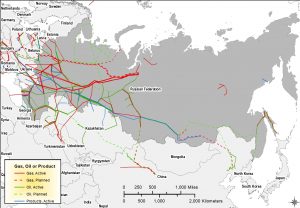87 Russian Domain: Economic Geography I – Natural Gas
Russian Domain: Economic Geography I
Russia is by far the largest country in the world by land area. Even by simple probability, it is likely that Russia would hold a variety of natural resources, some in high quantities. Indeed, that is true, as Russia has a vast supply of natural resources, especially in the expansive areas of Siberia.
Energy resources are included in very large reserves in Russia, both oil and natural gas. Given that reserves by definition are not yet extracted, they are estimates, though generally well calculated. By most estimates, Russia is the world’s leader in natural gas reserves with proven reserves of 1668 trillion cubic feet (47 trillion cubic meters). This is about ¼ of the world’s reserves and is approximately 3.5 times that of the United States (#4 in the world (Iran #2, Qatar #3)).
An excellent map of Russia’s top ten oilfields and top ten natural gas fields can be seen at:
http://shop.theoilandgasyear.com/major-producing-fields-in-russia-2013/. The Urengoy (or Urengoi) gas field in western Siberia has been Russia’s key gas field for many years, after being discovered in 1966 with production being initiated in 1978. Urengoy is the second largest gas field and the most productive in the world. There are natural gas fields in numerous locations in Russia, but clearly Siberia holds the greatest reserves.
The challenge for the economic exploitation of this energy resource was significant, given its location in a frigid climate. Even though western Siberia is the nearest portion of Siberia to the populated portions of Russia and to industry there and in the Ural Mountains, transportation of the gas to those locations still required construction and installation of extensive pipelines across difficult landscapes. As climate change affects Russia, construction and maintenance of infrastructure in Siberia becomes more and more tricky. Much of Siberia, especially so the northern locations, features permafrost soils. Every summer the active layer, the top meter or more, melts. This causes anything built on these surfaces – houses, pipelines, railroad lines – to risk instability by shifting or moving. Engineers compensate for this risk in different ways; for instance, by pinning supports deeper through the permafrost into the unchanged strata below the active layer. However, as global warming heats Siberia, the active layer is extended deeper. Structures that once were secure may now become movable. Construction of new infrastructure must account for these greater risks. Pipelines and the structural supports holding the pipelines are at risk of shifting or breaking. New pipelines and maintenance of old pipelines necessarily must adjust.

The Soviet Union’s interest in developing its natural gas potential began during World War II, when wartime disruption of coal supplies, its main source of heat and energy, caused hardships. Discovery of vast natural gas fields in western Siberia in the 1960s demonstrated the potential for this choice of energy. Utilizing these fields demanded considerable investment and labor, but proved to be worthwhile for domestic use. Subsequently as the Soviet Union and then Russia sought to deliver the gas even farther, that is, to Eastern Europe and beyond into countries like Germany, these pipelines stretched greater and greater distances. The international sales of Russian natural gas proved to be more than simple economic transactions, but became geopolitical topics of concern as well.
The breakup of the Soviet Union fractured the country into fifteen new countries. The former republics, particularly to the west of Russia, had been domestic consumers of Soviet natural gas from Siberia. As these new countries, they remained customers of Russian gas from Siberia, but now with geopolitical aspects to this energy trade. For instance, Ukraine became a new country with mixed feelings toward the new Russia. Ukrainians shared linguistic, ethnic, and historical connections with Russia, yet also often sought to break the post-Soviet links by looking westward to Europe for trade and politics. The new Russia strongly opposed these pro-Western aspects of new Ukrainian ideas. One lever used by Russia to influence Ukrainian geopolitical leanings was the natural gas dependency. For instance, in January 2009, for thirteen cold winter days in Ukraine, Russia suspended the flow of gas to pipelines into Ukraine, while renegotiating the economic terms of their energy trade. Although the terms may have been economic, the framework of the crisis was the political reminder that Russia controls Ukraine’s winter heating and can turn that off when it feels the geopolitical need.
Similarly, as of 2013, former Soviet republics and now independent Baltic countries – Estonia, Latvia, Lithuania – were 100% dependent on Russia for natural gas. While Russia certainly utilizes natural gas in its industrial and residential sectors, it also exports a considerable share to several European countries, as seen in overall totals in the chart linked below.
https://tinyurl.com/naturalgastoEurope
These too have geopolitical implications. In 2013, Germany bought 46% of its natural gas supply from Russia. The United States currently is applying political pressure on Germany to reduce its purchases of natural gas from Russia, arguing that this economic link benefits Russia at a time that Europe and America should seek to weaken Russia.
Geopolitical factors now are affecting two major Russian pipeline expansions. Nord Stream 2 is a proposed doubling of an existing undersea pipeline that would bring natural gas from near St. Petersburg, under the Baltic Sea, to northern Germany. Although American economic sanctions against Russia and against companies doing certain types of business with Russia have hindered the project, it appears that Russia will complete the work by winter 2021.
To the south, Russia has faced obstacles as well. The political backlash from its annexation of Crimea from Ukraine in 2014 effectively scuttled Russia’s proposed South Stream. Those plans were replaced by the successful Turk Stream that runs under the Black Sea from Russia to Kiyikoy, Turkey, initiating gas flows to Bulgaria at the start of 2020.
Gazprom is the world’s largest natural gas corporation. https://www.gazprom-international.com/

Natural gas can used and transported for a variety of uses and products. Here is a small section of pipeline transporting ammonia from Tolyatti, Russia, to Odessa, Ukraine.
Cited and additional bibliography:
Adduci, Joseph. 2020. “Russia’s Energy Pipelines.”
Bourne, Jr., Joel K. 2019. “See Russia’s Massive New Gas Plant on the Arctic Coast.” Environment. March 22, 2019. https://www.nationalgeographic.com/environment/2019/03/sabetta-yamal-largest-gas-field/.
Ghirlandajo. 2009. Ammonia Pipeline. https://commons.wikimedia.org/wiki/File:Ammiakoprovod_NS.jpg. Creative Commons Attribution-Share Alike 2.5 Generic.
Lee, Julian. 2019. “Bloomberg – Are You a Robot?” Bloomberg.Com. September 29, 2019. https://www.bloomberg.com/opinion/articles/2019-09-29/climate-change-russia-s-oil-and-gas-heartlands-are-under-threat.
Riva, Joseph P., Gordon I. Atwater, Lee H. Solomon, John E. Carruthers, and A. L. Waddams. n.d. “Natural Gas – Location of Major Gas Fields.” Encyclopedia Britannica. Accessed August 2, 2020. https://www.britannica.com/science/natural-gas/Location-of-major-gas-fields.
“Russia Natural Gas Reserves, Production and Consumption Statistics – Worldometer.” n.d. Www.Worldometers.Info. Accessed August 2, 2020. https://www.worldometers.info/gas/russia-natural-gas/.
Shiryaevskaya, Anna. 2020. “Vessel Option Emerges to Complete Sanctioned Nord Stream 2 Pipeline.” Www.Worldoil.Com. February 17, 2020. https://www.worldoil.com/news/2020/2/17/vessel-option-emerges-to-complete-sanctioned-nord-stream-2-pipeline.
siesta. 2019. “What Are the Largest Natural Gas Fields in Russia?” NS Energy. June 21, 2019. https://www.nsenergybusiness.com/features/largest-natural-gas-fields-in-russia/.
U.S. Energy Information Administration. 2018. Europe Natural Gas Supply Composition (2010-2017). https://commons.wikimedia.org/wiki/File:Europe_natural_gas_supply_composition_(2010-2017)_(44636201715).png. Public Domain.


